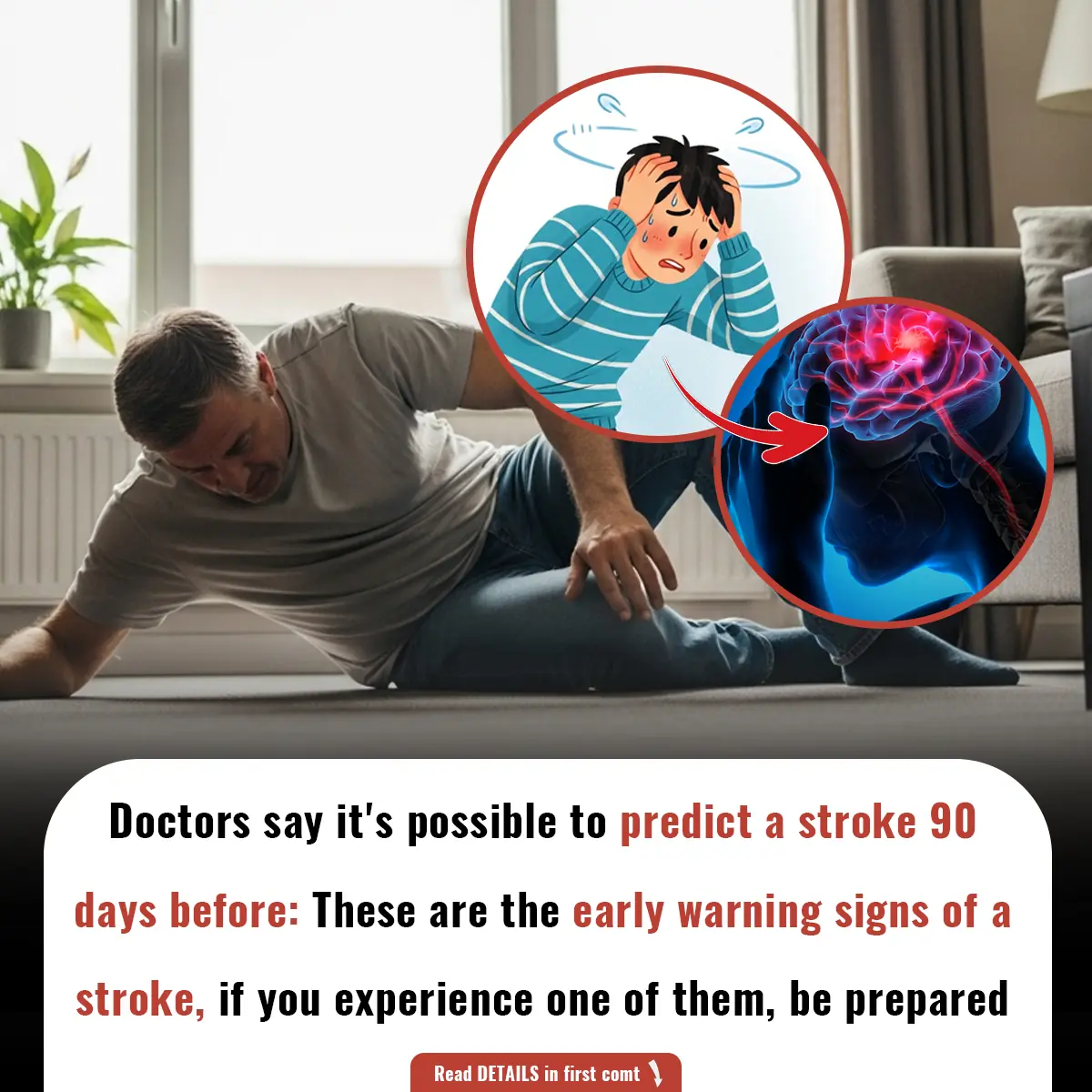
1 type of headache that requires immediate hospitalization, don't hesitate
Cerebral hemorrhage, also known as intracerebral hemorrhage or brain bleed, is one of the most dangerous medical emergencies that can occur unexpectedly and lead to devastating consequences, including permanent brain damage or death. This condition arises when blood vessels rupture inside the brain, causing blood to flow into and damage brain tissue.
One of the earliest and most common warning signs of cerebral hemorrhage is a severe headache. Yet, because headaches are so common and often harmless, these critical symptoms can be easily overlooked - sometimes with fatal results.
In this article, we will delve deeply into the nature of cerebral hemorrhage, the urgent symptoms you must never ignore, common causes, and practical strategies for prevention. We will also examine a tragic real-life story that highlights how quickly this condition can become life-threatening.
Understanding Cerebral Hemorrhage: What Happens Inside Your Brain?
Cerebral hemorrhage occurs when a blood vessel within the brain bursts, spilling blood into the surrounding brain tissue. This causes swelling, increased pressure inside the skull (intracranial pressure), and damage to delicate brain cells. Unlike ischemic strokes, which result from a blocked blood vessel, hemorrhagic strokes are caused by bleeding and often have more severe effects.
The increased pressure can compress vital areas of the brain, interrupting normal function and leading to neurological deficits. If untreated or severe, it can cause rapid deterioration and death.
The Tragic Case of Siti Saraf Ismail: A Warning to All
To understand the seriousness of cerebral hemorrhage, consider the heartbreaking story of Siti Saraf Ismail, a young woman who suffered a fatal brain hemorrhage shortly after her wedding.
At around 3 AM, Siti woke her husband, Mohamad Amirul Akmal Mohd Aziz, complaining of a severe headache. Though she seemed to rest well afterward, her family later found her struggling to breathe. Emergency services rushed her to the hospital, but despite medical efforts, she passed away within half an hour.
The autopsy revealed a hemorrhage on the right side of her brain as the cause of death. Amirul recalls one of her last words: “Honey, we are married now, you must always take care of your family members.”
Siti’s story is tragically common. Cerebral hemorrhages can occur suddenly, with symptoms that mimic ordinary headaches, lulling patients and families into a false sense of security.
Recognizing the Symptoms: When to Be Alert
Cerebral hemorrhage can start abruptly and progress rapidly. Symptoms may develop during physical or mental exertion, routine activities, or even during sleep or upon waking.
Key warning signs include:
1. Sudden, Severe Headache
- Often described as the worst headache ever experienced.
- May come on without warning and is typically localized to one side.
2. Weakness or Paralysis
- Sudden weakness, numbness, or paralysis affecting one side of the body.
- Difficulty standing or falling toward one side.
3. Speech Difficulties
- Slurred, slow, or unclear speech.
- Trouble understanding others or forming sentences.
4. Facial Drooping or Distortion
- One side of the face appears to droop.
- Difficulty smiling symmetrically.
5. Visual Problems
- Blurred, double vision, or loss of vision in one or both eyes.
6. Nausea and Vomiting
- Sudden onset of nausea or repeated vomiting.
7. Loss of Consciousness or Coma
- Drowsiness, confusion, or inability to stay awake.
- Severe cases lead to coma.
8. Irregular Breathing and Heart Rate
- Breathing may become erratic.
- Heart rate and blood pressure can fluctuate dangerously.
9. Sweating and Incontinence
- Excessive sweating without physical activity.
- Loss of bladder or bowel control.
10. Swallowing Difficulties
- Difficulty chewing or swallowing, choking episodes.
11. Rapid Memory Loss or Disorientation
- Sudden forgetfulness or confusion about time and place.
If you or someone near you experiences any combination of these symptoms, seek emergency medical attention immediately. Time is critical to reduce brain damage and improve survival chances.
What Causes Cerebral Hemorrhage?
Several factors and conditions can cause or increase the risk of cerebral hemorrhage. Understanding these causes can help you better protect yourself.
1. High Blood Pressure (Hypertension)
- The most common non-traumatic cause.
- High blood pressure damages blood vessel walls over time, making them prone to rupture.
2. Head Trauma
- Falls, motor vehicle accidents, sports injuries, or physical assault can cause vessels to burst.
- Trauma-related hemorrhages can occur immediately or develop hours after injury.
3. Brain Aneurysms
- Weak spots in blood vessels that bulge and may rupture.
- Can cause sudden hemorrhagic stroke with no prior symptoms.
4. Arteriovenous Malformations (AVMs)
- Abnormal tangles of arteries and veins in the brain.
- These malformed vessels are fragile and can bleed spontaneously.
5. Cerebral Amyloid Angiopathy
- Build-up of amyloid protein deposits in brain arteries.
- Common in older adults, increases vessel fragility.
6. Brain Tumors
- Tumors can press on vessels causing them to rupture.
- Some tumors have abnormal vessels prone to bleeding.
7. Blood Clotting Disorders
- Conditions or medications that affect blood clotting increase bleeding risk.
- Anticoagulants and antiplatelet drugs (blood thinners) can contribute.
8. Lifestyle Factors
- Smoking, heavy alcohol use, and illicit drugs like cocaine damage blood vessels.
- These substances increase the likelihood of vessel rupture.
9. Pregnancy-Related Conditions
- Eclampsia and postpartum vascular complications can cause brain hemorrhage.
- Newborns may experience intraventricular hemorrhage (bleeding inside the brain).
10. Genetic and Structural Disorders
- Some people have inherited collagen defects weakening vessel walls.
- Other rare conditions may predispose to hemorrhage.
Diagnosing Cerebral Hemorrhage: What Happens in the Hospital?
If cerebral hemorrhage is suspected, doctors perform several tests to confirm the diagnosis and determine severity:
- Neurological Examination: Assessing speech, strength, reflexes, and consciousness.
- CT Scan (Computed Tomography): Quickly detects bleeding and swelling in the brain.
- MRI (Magnetic Resonance Imaging): Provides detailed images of brain tissue.
- Angiography: Imaging blood vessels to locate aneurysms or AVMs.
- Blood Tests: Checking clotting function, blood sugar, and infection.
Emergency Treatment and Management
Cerebral hemorrhage requires immediate medical intervention:
- Stabilizing Airway and Breathing: Ensuring oxygen delivery.
- Controlling Blood Pressure: To prevent further bleeding.
- Surgery: May be needed to remove blood clots or repair damaged vessels.
- Medications: To reduce brain swelling, prevent seizures, and manage pain.
- Rehabilitation: Long-term physical, speech, and occupational therapy.
Despite advances, cerebral hemorrhage remains associated with high mortality and disability rates.
Prevention: How To Lower Your Risk of Cerebral Hemorrhage
Medical experts emphasize that prevention is paramount. While some risk factors like genetics can’t be changed, lifestyle and medical management play crucial roles.
1. Control High Blood Pressure
- Regularly monitor blood pressure.
- Follow prescribed treatments.
- Maintain a healthy weight and reduce salt intake.
2. Maintain a Healthy Diet
- Eat plenty of green leafy vegetables, fruits, and whole grains.
- Limit saturated fats and cholesterol.
- Reduce processed and fried foods.
3. Avoid Smoking and Excessive Alcohol
- Smoking damages blood vessels and accelerates hypertension.
- Excessive alcohol consumption increases bleeding risk.
4. Exercise Regularly
- Aim for 30 to 45 minutes of moderate exercise daily.
- Physical activity helps control blood pressure and improves vascular health.
5. Manage Chronic Conditions
- Diabetes, high cholesterol, and heart disease should be well controlled.
- Regular medical check-ups are essential.
6. Avoid Illicit Drug Use
- Drugs such as cocaine and amphetamines dramatically increase hemorrhage risk.
7. Use Medications Wisely
- Take anticoagulants and blood thinners only under medical supervision.
- Report any side effects or bleeding symptoms immediately.
Conclusion: Act Fast, Stay Informed, and Protect Your Brain
Cerebral hemorrhage is a life-threatening condition that can strike without warning. The hallmark symptom - sudden severe headache - should never be ignored, especially if accompanied by weakness, speech difficulties, or altered consciousness.
The tragic loss of individuals like Siti Saraf Ismail reminds us of the devastating speed and severity of this disease. Awareness, early recognition, and rapid medical intervention save lives.
By adopting healthy lifestyle choices, managing medical conditions, and recognizing warning signs, you can dramatically reduce your risk of cerebral hemorrhage and protect your most vital organ: your brain.
News in the same category


How to Position Your TV in the Living Room for Optimal Health and Wealth

Hidden D@ngers on Your Dinner Plate: 3 Common Vegetables That May Be D@m@ging Your Digestive Health

Doctors warn just one glass of this drink a day could increase risk of being diagnosed with cancer
A doctor in New York City has discovered a worrying trend between a drink almost two-thirds of Americans enjoy and an aggressive cancer.

Many Confuse This Plant with a Weed, But It’s Actually Full of Surprising Health Benefits
From providing omega-3 fatty acids to supporting heart, bone, and kidney health, purslane offers a wide range of benefits.

Doctor reveals the one sound people make that means they have under 24 hours left to live
This phenomenon is most commonly observed as the person drifts in and out of consciousness, and their breathing becomes more labored.

Don't Underestimate This Common Feature of Rice Cookers: It Could Be Harmful to Your Health

Smart People Know This Trick: Save Up to 50% on Your Monthly Electricity Bill by Adjusting Your Air Conditioner

Why Smart People Often Insert a Key into the Door When Sleeping: A Simple Habit with Big Benefits

The Surprising Benefits of Placing Ginger Under Your Pillow Before Sleep

6 Groups Who Should Avoid Eating Jackfruit: 2 Common Mistakes to Prevent Health Issues

Boost Your Toilet's Flushing Power Instantly with This Simple Trick

5 Essential Habits to Prevent C@ncer Recurrence: Insights from a Japanese Doctor

Four Brothers Diagnosed with Stomach C@ncer: Doctors Identify Two Common Habits as Major Risk Factors

When defrosting fish, remember not to soak it in water. The fishmonger taught me a trick to defrost it quickly, still fresh like raw fish

Doctors say it's possible to predict a stroke 90 days before: These are the early warning signs of a stroke, be prepared

Eat 4 foods on an empty stomach in the morning to help clean the intestines, improve digestion, and prevent c@ncer

Ginger left for a long time often dries up. Here are ways to preserve fresh ginger for a long time, so it won't spoil all year round.

The Hidden Function of the Small Hole in Your Nail Clipper

Family's Thyroid Tumor Discovery: A Cautionary Tale About Excessive Iodized Salt and Soy Sauce Consumption
News Post

Why Smart People Never Set Their Air Conditioner to 26°C at Night

How to Position Your TV in the Living Room for Optimal Health and Wealth

Hidden D@ngers on Your Dinner Plate: 3 Common Vegetables That May Be D@m@ging Your Digestive Health

Doctors warn just one glass of this drink a day could increase risk of being diagnosed with cancer
A doctor in New York City has discovered a worrying trend between a drink almost two-thirds of Americans enjoy and an aggressive cancer.

Many Confuse This Plant with a Weed, But It’s Actually Full of Surprising Health Benefits
From providing omega-3 fatty acids to supporting heart, bone, and kidney health, purslane offers a wide range of benefits.

Doctor reveals the one sound people make that means they have under 24 hours left to live
This phenomenon is most commonly observed as the person drifts in and out of consciousness, and their breathing becomes more labored.

Easy Recipe to Make Rice Water Cubes to Shrink Pores and Get Clear, Radiant Skin
Rice water ice cubes are a simple yet effective skincare treatment that provides immediate benefits and can be easily incorporated into your weekly skincare routine.

5 Homemade Skin Toners for Glowing Skin, Acne, and Dark Spots: Natural Remedies for Healthy, Radiant Skin
Homemade toners are a simple, affordable, and effective way to address common skin concerns such as acne, dark spots, wrinkles, and enlarged pores.

Don't Underestimate This Common Feature of Rice Cookers: It Could Be Harmful to Your Health

Smart People Know This Trick: Save Up to 50% on Your Monthly Electricity Bill by Adjusting Your Air Conditioner

Homemade Aloe Vera Gel to Erase Wrinkles on Your Face: A Natural, DIY Anti-Aging Treatment
By using natural ingredients like cooked rice, almond oil, and aloe vera gel, you can create a powerful DIY mask that helps reduce wrinkles, improve skin elasticity, and nourish your skin.

Why Smart People Often Insert a Key into the Door When Sleeping: A Simple Habit with Big Benefits

The Surprising Benefits of Placing Ginger Under Your Pillow Before Sleep

Botox in a Bowl: A Natural Nightly Gel for Smooth, Wrinkle-Free Skin
These DIY face gels are a great, natural alternative to expensive anti-aging treatments.

6 Groups Who Should Avoid Eating Jackfruit: 2 Common Mistakes to Prevent Health Issues

Boost Your Toilet's Flushing Power Instantly with This Simple Trick

5 Essential Habits to Prevent C@ncer Recurrence: Insights from a Japanese Doctor

Four Brothers Diagnosed with Stomach C@ncer: Doctors Identify Two Common Habits as Major Risk Factors

DIY Chia Seeds and Aloe Vera Mask for Wrinkle-Free, Radiant Skin: Achieve Youthful, Glass-Like Skin Naturally
Regular use of this DIY chia seeds aloe vera mask can help you achieve that coveted glass skin look-soft, plump, and glowing
